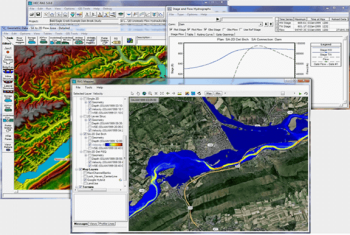One-Dimensional Hydraulic Models

|
| HEC-RAS is a program commonly used to generate one-dimensional hydraulic models.
(Image Source: Hydrologic Engineering Center, USACE) |
“One-dimensional models solve either fully dynamic or simplified forms of conservative or non-conservative forms of one-dimensional, cross-section-averaged shallow water equations. One-dimensional models provide reliable results for many situations; however, one-dimensional models in unconfined floodplains do not accurately represent the breach flood wave moving downstream..." [1]
"One dimensional models are best suited to geographic regions with moderate to steep slopes whereby floodwaters are contained within a relatively narrow floodplain and generally flow in the direction of a single stream line without major or frequent divergence of flow. Confined floodplains are found in most parts of the United States and can range from deep entrenched rivers located within mountain ranges to wide coastal plain rivers. Confined floodplains typically present the engineer with a one-dimensional problem for which the one-dimensional assumption of many hydraulic models can yield meaningful results."[1]
“One-dimensional models only provide a depth and discharge at computational cross-sections along the river. Although this process may be appropriate for confined alluvial floodplains/channels, errors in the unsteady simulation may be introduced in unconfined flat areas."[1]
“When a flood wave enters an unconfined floodplain, one-dimensional routing is no longer a valid assumption. Geographic regions with flat to mild slopes, areas of depressed terrain, poorly defined flow paths, alluvial fans, and fluvial areas typically exhibit unconfined floodplains whereby floodwaters are not contained within a well-defined floodplain and generally flow in multiple directions, often with frequently diverging and converging flows. Unconfined floodplains are highly unpredictable and can exhibit both deep and shallow flooding with significant lateral differences in water surface elevations. Unconfined floodplains are found in areas ranging from flat swampy areas and coastal regions to mountain valleys."[1]
“In flat areas, the results of a dam break are likely to be largely influenced by the location of the breach because the flat terrain has the potential to allow dam break floodwaters to flow in many directions without being confined to a river valley."[1]
“Areas below a dam may exhibit both confined and unconfined floodplains. An example of this would be a dam located along a mountain river that flows out into a large valley via an alluvial fan. The mountain river may exhibit a steep, deeply entrenched confined floodplain until it reaches the alluvial fan upon which the slope of the river decreases suddenly and becomes a very unpredictable unconfined floodplain as it diverges and spreads out across a wide alluvial fan and continues into a wide fluvial floodplain”."[1]
Best Practices Resources
Trainings
Citations:
Revision ID: 7427
Revision Date: 07/21/2023
